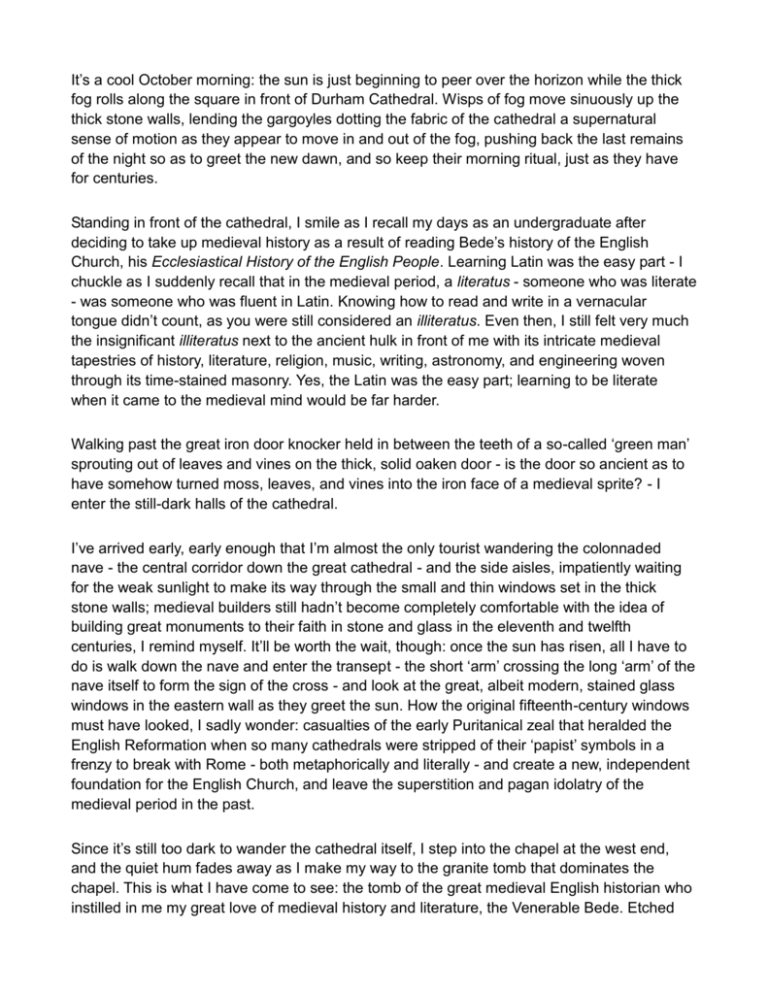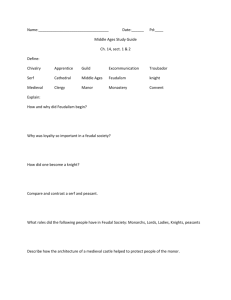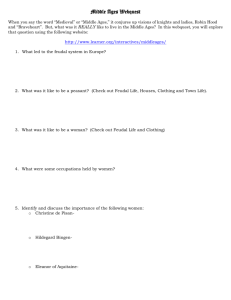In the Middle_Literacy and the Middle Ages
advertisement

It’s a cool October morning: the sun is just beginning to peer over the horizon while the thick fog rolls along the square in front of Durham Cathedral. Wisps of fog move sinuously up the thick stone walls, lending the gargoyles dotting the fabric of the cathedral a supernatural sense of motion as they appear to move in and out of the fog, pushing back the last remains of the night so as to greet the new dawn, and so keep their morning ritual, just as they have for centuries. Standing in front of the cathedral, I smile as I recall my days as an undergraduate after deciding to take up medieval history as a result of reading Bede’s history of the English Church, his Ecclesiastical History of the English People. Learning Latin was the easy part - I chuckle as I suddenly recall that in the medieval period, a literatus - someone who was literate - was someone who was fluent in Latin. Knowing how to read and write in a vernacular tongue didn’t count, as you were still considered an illiteratus. Even then, I still felt very much the insignificant illiteratus next to the ancient hulk in front of me with its intricate medieval tapestries of history, literature, religion, music, writing, astronomy, and engineering woven through its time-stained masonry. Yes, the Latin was the easy part; learning to be literate when it came to the medieval mind would be far harder. Walking past the great iron door knocker held in between the teeth of a so-called ‘green man’ sprouting out of leaves and vines on the thick, solid oaken door - is the door so ancient as to have somehow turned moss, leaves, and vines into the iron face of a medieval sprite? - I enter the still-dark halls of the cathedral. I’ve arrived early, early enough that I’m almost the only tourist wandering the colonnaded nave - the central corridor down the great cathedral - and the side aisles, impatiently waiting for the weak sunlight to make its way through the small and thin windows set in the thick stone walls; medieval builders still hadn’t become completely comfortable with the idea of building great monuments to their faith in stone and glass in the eleventh and twelfth centuries, I remind myself. It’ll be worth the wait, though: once the sun has risen, all I have to do is walk down the nave and enter the transept - the short ‘arm’ crossing the long ‘arm’ of the nave itself to form the sign of the cross - and look at the great, albeit modern, stained glass windows in the eastern wall as they greet the sun. How the original fifteenth-century windows must have looked, I sadly wonder: casualties of the early Puritanical zeal that heralded the English Reformation when so many cathedrals were stripped of their ‘papist’ symbols in a frenzy to break with Rome - both metaphorically and literally - and create a new, independent foundation for the English Church, and leave the superstition and pagan idolatry of the medieval period in the past. Since it’s still too dark to wander the cathedral itself, I step into the chapel at the west end, and the quiet hum fades away as I make my way to the granite tomb that dominates the chapel. This is what I have come to see: the tomb of the great medieval English historian who instilled in me my great love of medieval history and literature, the Venerable Bede. Etched into the black marble cover are the words I’ve travelled thousands of miles to see: HIC SUNT IN FOSSA BEDAE VENERABILIS OSSA. Here are buried the bones of the Venerable Bede. Such a maddeningly simple epitaph for one of England’s greatest monks, a man who spent his life disseminating the knowledge of late antiquity and the early medieval period throughout England and, eventually, northern Europe. Suddenly, I realise that the morning light is beginning to chase away the shadows in the chapel: unlike the cathedral, the windows here are low enough to admit the low-lying fall light. I cannot help but smile: so many people consider the medieval period to be nothing but the Dark Ages, a period full of superstitious ignorance whose only saving grace was incubating the spirit of classical antiquity until its rediscovery in the Renaissance. Yet here I stand in a sunlit chapel from the fourteenth century, my only company the dusty bones of one who had so long ago written that study, teaching, and writing had always been his delights. The sun still hasn’t quite risen enough to light up the cathedral itself as I step out of the chapel, so I let myself out into the monastic cloisters that hug the southern wall of the cathedral. The sunlight illuminates the covered quadrangle with a perfectly manicured lawn in the centre, that quintessential monument to Englishness that’s seemingly present at every historic site throughout England. Wandering the quadrangle, I admire the wooden ceiling still dotted with medieval bosses, knobs of wood marking the intersection of ribs holding up the vaulted ceiling. The cathedral builders allowed their imaginations free rein: here, blue-robed angels flit about, while elsewhere bosses carved into miniature coats of arms proclaim the heraldry of the great families from around the area. But above all, the builders proclaim both their love of nature and their sense of humour: so-called ‘green men’ surprise the viewer by suddenly popping out of intricate designs of leaves and vines with the most bizarrely contorted expressions, perpetual surprises of amusement to those wise enough to think to look up as they wander the cloisters. Suddenly one doesn’t begin to feel as if the medieval world is as far away or as different from ours as we often think it is. Just as I’m about to take another turn around the quadrangle, I hear the choir in the cathedral begin singing a hymn. I look around, half-expecting a tardy monk to come rushing out of the dormitory on the opposite side of the quadrangle to join his companions in singing the office of Prime to welcome the dawn as the sun has finally risen enough to shine its light through the windows Following the time-worn steps of my imaginary monk as he hurries through the cloister door, I follow him as he rushes down the nave to the high altar at the other end of the cathedral. I part ways with him at the crossing: he continues eastward towards the great altar, where the choir continues singing, and I turn to my right and enter the southern transept. Just as the last strains of the hymn fade away into the still-darkened vault above the nave, the sunlight floods through the stained glass windows in the eastern wall of the transept, lighting up the fabric of the western wall in a blaze of painted light. Bright white light from the celerestory windows running the length of the wall just beneath the vaulted ceiling plays across the coloured light on the western wall, giving the bright colours from the stained glass a soft pastel colour, hinting at the promise of a fresh spring day in a few months’ time. As the organ and choristers begin their bright song again, I realise the appropriateness of where I stand in Durham Cathedral. Behind me sits the thick and stout Romanesque nave of the eleventh and twelfth centuries; Bede lies in the small yet delicate fourteenth-century Galilee Chapel, and here I stand, in front of nineteenth-century stained glass windows with nothing but bones of stone in between them to support the weight of the vaulted ceiling. This is why I write and teach: this world of monks, popes, princes, and peasants, of wars and plagues, of Latin hymns and prayers, of abbeys and cathedrals is as like the stained glass that dominates the transept - full of light and colour and liveliness. The stone bones, by contrast, faithfully bear the weight not only of the vault, but of the centuries as well. To see only the plain stone columns as so many people do when they think of the medieval period and how ‘dark’ and pestilence-ridden it was, is to blind oneself to the wonder - and frustration - of chasing down the medieval mind as it breathed, hoped, and lived across Europe these long centuries ago. Perhaps I’ll never quite become fully literate in the world of medieval Europe no matter how long I study, read, write, and teach about it, but for that short hour spent in Durham Cathedral that chilly October morning, I stepped back into the medieval soul.







